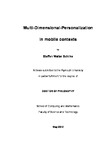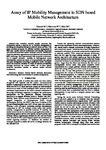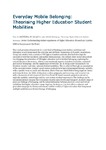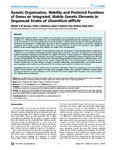Multi-Dimensional-Personalization in mobile contexts
| dc.contributor.supervisor | Furnell, Steven M., Prof. Dr. | |
| dc.contributor.author | Schilke, Steffen Walter | |
| dc.contributor.other | School of Engineering, Computing and Mathematics | en_US |
| dc.date.accessioned | 2013-07-17T13:52:45Z | |
| dc.date.available | 2013-07-17T13:52:45Z | |
| dc.date.issued | 2013 | |
| dc.identifier | 309656 | en_US |
| dc.identifier.uri | http://hdl.handle.net/10026.1/1576 | |
| dc.description.abstract |
During the dot com era the word "personalisation” was a hot buzzword. With the fall of the dot com companies the topic has lost momentum. As the killer application for UMTS or the mobile internet has yet to be identified, the concept of Multi-Dimensional-Personalisation (MDP) could be a candidate. Using this approach, a recommendation of mobile advertisement or marketing (i.e., recommendations or notifications), online content, as well as offline events, can be offered to the user based on their known interests and current location. Instead of having to request or pull this information, the new service concept would proactively provide the information and services – with the consequence that the right information or service could therefore be offered at the right place, at the right time. The growing availability of "Location-based Services“ for mobile phones is a new target for the use of personalisation. "Location-based Services“ are information, for example, about restaurants, hotels or shopping malls with offers which are in close range / short distance to the user. The lack of acceptance for such services in the past is based on the fact that early implementations required the user to pull the information from the service provider. A more promising approach is to actively push information to the user. This information must be from interest to the user and has to reach the user at the right time and at the right place. This raises new requirements on personalisation which will go far beyond present requirements. It will reach out from personalisation based only on the interest of the user. Besides the interest, the enhanced personalisation has to cover the location and movement patterns, the usage and the past, present and future schedule of the user. This new personalisation paradigm has to protect the user’s privacy so that an approach supporting anonymous recommendations through an extended "Chinese Wall“ will be described. | en_US |
| dc.language.iso | en | en_US |
| dc.publisher | University of Plymouth | en_US |
| dc.subject | Location based services | en_US |
| dc.subject | mobile marketing | en_US |
| dc.subject | mobile advertisement | en_US |
| dc.subject | mobile internet | en_US |
| dc.subject | personalization | en_US |
| dc.subject | mobile privacy | en_US |
| dc.subject | enhanced Chinese wall | en_US |
| dc.title | Multi-Dimensional-Personalization in mobile contexts | en_US |
| dc.type | Thesis | |
| plymouth.version | Full version | en_US |
| dc.identifier.doi | http://dx.doi.org/10.24382/3471 |
Files in this item
This item appears in the following Collection(s)
-
01 Research Theses Main Collection
Research Theses Main





